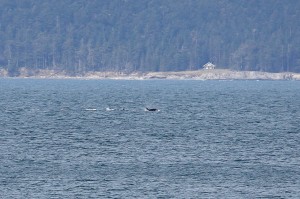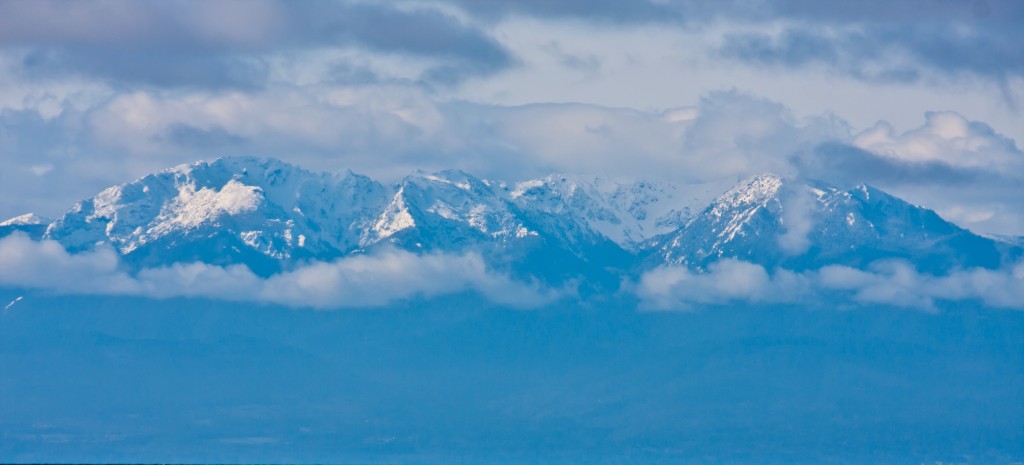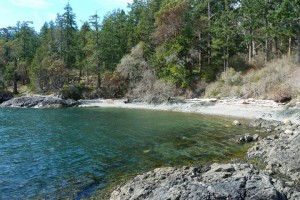Week 1!
Hello all! My name is Mandy, and I am a 3rd year Wildlife Ecology major from the University of Maine. We are already a week into the Spring ’11 Beam Reach program, and it would be an understatement to say that it’s been an eventful week so far.
We started our week off with a trip to Lime Kiln State Park (also known, appropriately so, as Whale Watch State Park). The State Park was absolutely GORGEOUS. It was a beautiful, sunny day, and you could see the Olympic Mountains towering over the water (above). Just as some background information about the park, it was mined for limestone to make into concrete back in the late 18 to 1900s. Kilns were built at the park to produce lime. This resulted in a lot of deforestation on the island, as trees needed to be cut down to keep the fires in the kiln going. Now, however, the forests are coming back, especially in the park area. We got to walk back and see one of the kilns that’s still standing, which was very cool.
So at any rate, we went to the park to brainstorm and discuss questions. We got to sit out on the rocks, in this beautiful setting, and come up with questions, then moved inside to the warmer lighthouse to discuss our questions with everyone. It was as we were discussing our questions that it happened. Kelsey was talking to Scott about one of her questions, when all of a sudden she stopped talking, left her mouth hanging open, and just kind of stared off out the window over Scott’s shoulder. Then her eyes got huge. It was most definitely the face of someone who had seen something. Turns out, she hadn’t just seen something, she had seen ORCAS! We all promptly grabbed binoculars and ran outside. There was a group of what turned out to be about 9 whales. We watched them a bit from the Light House, then ran and hopped into the car and journeyed up to Val’s house. We got there just in time, as they were passing right by. They were a ways out, but they were lunging and were definitely visible.
It was awesome because, not only were they killer whales, but they were transients! Apparently there was about a 1 in a 1,000 chance that we would ever see them. The hydrophone never picked up any calls, so we were very lucky that Kelsey happened to be looking in the right place at the right time. We were also mentioned (although not by name) in a blog by Jeanne (check it out), who we all hope to meet soon!


So, for those of you who don’t know, there are three different ecotypes of killer whales found in these waters. The first is residents (such as the beloved Southern Resident killer whales (SRKW) that we will be focusing our research efforts on, as well as the Northern Residents). The resident pods are fish-eating pods. They eat primarily Chinook salmon. Our SRKWs are found in three pods: J, K, and L. They are known for being quite vocal (which makes them prime candidates for bioacoustic research). In contrast, transients are mammal-eating. They are usually found in smaller pods, and are usually much quieter then residents are.  Then there are the offshore killer whales. Although believed to be genetically closest to residents, very little is known about offshores. They are usually found in large groups out in more open water, and it is believed that they feed on sharks and other fish. Offshores are also typically smaller than the other two ecotypes, and they make strange and haunting calls (Offshore calls were recently picked up on hydrophones in our area, and were recorded by Jan Twillert from Holland, an active listener of the hydrophone network maintained by Paul and Helena Spong at the north end of Vancouver Island).
Seeing the transients has definitely been the highlight of the program for me so far. However, it has all been awesome. I can’t get over how fantastically gorgeous it is out here. The islands are beautiful, and everyone is so friendly. We’ve learned a ton too. Probably my favorite talk was by Monika Wieland, who told us a little about the natural history of the SRKWs. She told us a lot of interesting stuff about the whales, and also a lot about acoustics. Jason Wood talked about bioacoustics, which was very interesting for me, as I’ve done a bit of acoustical work with bats in New York. Kari Koski came in and talked to us about the Soundwatch Program, which helps educate boaters on ‘being whale-wise.’ Because there has been evidence that the whales are affected by the constant vessel traffic around them, this is extremely important. Finally Anna Kagley talked to us about salmon in the area, which I thought was really interesting as well. Obviously, as the SRKWs primary prey, the fate of the salmon is tied with the fate of the whales. Furthermore, I read about a study done by Drs. Eric Ward and Eli Holmes, whose preliminary results suggest that the birth rate of the whales is most affected by Chinook salmon abundance than any of the other threats analyzed (vessel interactions and exposure to toxins). Therefore, it’s very good that efforts are being made to help understand the Chinook salmon population!

Vessels and resident whales... Helps highlight one of the threats to the whales (Photo credit to Kari Koski)













 Twitter
Twitter LinkedIn
LinkedIn Facebook
Facebook